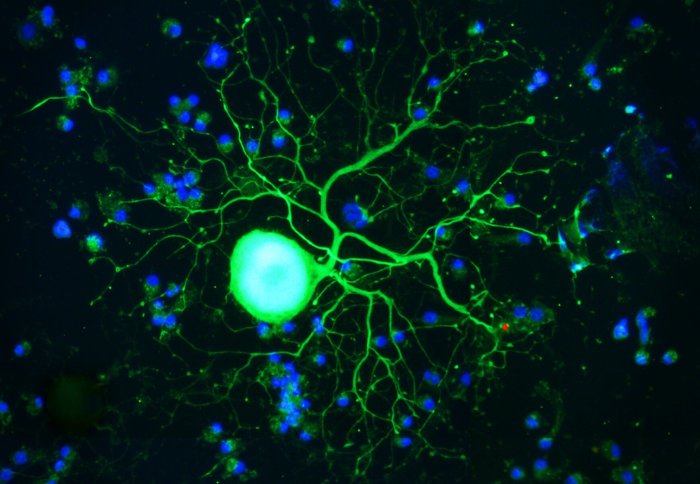Epigenomic “map” helps predict nerve cells’ ability to regenerate after injury

Dorsal root ganglion - a specific kind of nerve cell
An Imperial-led study has provided new insights into the biological processes which determine nerve cells’ ability to regenerate after injury.
The study, published today in Nature Neuroscience, sheds new light on why nerve cells found in our peripheral nervous system can regenerate following injury, whereas those found in our central nervous system (CNS) cannot.
In mapping the biological processes that turn genes “on” and “off” (epigenetics), thereby enabling peripheral nerve cells to regenerate, the research identifies potential targets for boosting regeneration and recovery in the CNS. Using a machine learning approach, the findings also demonstrate how these specific epigenetic markers can be used to help predict regeneration following injury.
Epigenetic exploration
Previous research has shown that nerve cells’ ability to regenerate in the peripheral nervous system partly depends on the activation of gene transcription. This important process, which leads to the synthesis of new proteins, is in turn affected by the extent to which chromatin - a mass of genetic material composed of DNA and proteins – is compacted in cells. When chromatin is densely packed, genes are sealed off from the molecular mechanisms that activate the transcription process.
In this study, researchers from the Di Giovanni Lab at Imperial set out to understand the different biological processes that regulate chromatin compaction. The team focussed their analysis on a specific network of nerve cells known as dorsal root ganglia, which are found in both the central and peripheral nervous system. This allowed the team to compare which molecular events were, or were not, being triggered at either site following an injury to nerve cells.
Finding the flags
The results of the study confirm that chromatin plays a crucial role in nerve cells’ ability to regenerate after injury. The team observed that, following injury in the peripheral nervous system, chromatin is “open” and allows gene transcription to take place, which subsequently leads to regeneration. Conversely, in the CNS, chromatin is in a “locked” state after injury.
The researchers found that this difference was underpinned by the presence of specific epigenomic “flags”, which could be seen in the chromatin of nerve cells following injury to the peripheral nervous system, making it less compact. By contrast, these flags were missing in nerve cells observed in the CNS after injury.
The team also developed machine-learning algorithms which demonstrated that the epigenetic markers go some way to predict changes in gene expression following nerve cell injury and, in turn, the nerve cells' ability to regenerate.
Next steps
"We need to find tools to ‘open’ the chromatin, in order to promote the activation of gene expression required for successful regeneration" Dr Ilaria Palmisano Research Associate, Imperial College London
Commenting on the wider implications of the study, first author Dr Ilaria Palmisano, Research Associate at Imperial's Division of Neuroscience in the Department of Brain Sciences, said: “This study reveals that if we want to promote axonal regeneration, we need to find tools to ‘open’ the chromatin, in order to promote the activation of gene expression required for successful regeneration.”
“In our study, we have identified the specific genomic locations where we should make this happen. We have proposed some chromatin regulators that we might activate in the future to achieve this goal.”
She adds: “The limitations of this study are that it fails to address the heterogeneity of the cellular response to injury at the single cell level.”
“This is an important aspect to consider because, since the nervous system exchanges information across a complex heterogeneous cellular network, successful regeneration requires the integration of the molecular responses to injury by multiple cells to orchestrate the regenerative events.”
- ‘Epigenomic signatures underpin the axonal regenerative ability of dorsal root ganglia sensory neurons’ by Ilaria Palmisano, Matt C. Danzi et al. is published in Nature Neuroscience.
- Find out more about the latest research from the Di Giovanni Lab at Imperial College London.
- Image credit: "Entensive branching of sensory neurons" by Despina Stefanoska.
Article text (excluding photos or graphics) © Imperial College London.
Photos and graphics subject to third party copyright used with permission or © Imperial College London.
Reporter
Ms Genevieve Timmins
Academic Services